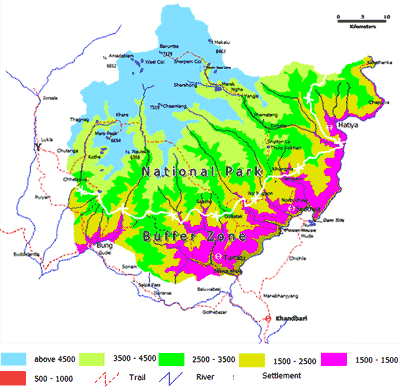 The
park and conservation area is situated in the
Sankhuwasabha and Solukhumbu districts, bordered
by the Arun River on the east, Sagarmatha (Mt.
Everest) National Park on the west, the Nepal-Tibet
border on the north and Saune Danda (ridge)
to the south. The Park covers 2,330 sq. kms.
The
park and conservation area is situated in the
Sankhuwasabha and Solukhumbu districts, bordered
by the Arun River on the east, Sagarmatha (Mt.
Everest) National Park on the west, the Nepal-Tibet
border on the north and Saune Danda (ridge)
to the south. The Park covers 2,330 sq. kms.
This is the only protected area
in Nepal with designation of a Strict Nature
Reserve. It has some of the richest and most
unique pockets of plants and animals in Nepal,
elsewhere lost to spreading human habitation.
Stepping up the slopes are a series of vegetation
zones starting with tropical sal forest below
1,000 m. elevation subtropical schima-castanopsis
forest at 1,000-2000 m. fir, birch, rhododendron
forests in the sub-alpine(3,000-4,000 m); and
herbs, grasses and rhododendron/juniper shrubs
in the alpine pas trues (4,000-5,000 m). There
are 47 varieties of orchids, 67 species of bamboos,
15 oaks including Arkhoulo, 86 species of fodder
trees and 48 species of primrose. Over 400 species
of birds have been sighted in the Makalu-Barun
area, including two species never before seen
in Nepal the spotted wrenbabbler and the olive
ground warbler. Wildlife includes the endangered
red panda, musk deer, Himalayan black bear,
clouded leopard and possibly snow leopard, in
addition to more substantial populations of
ghoral, thar, wild boar, barking deer, Himalayan
marmot and weasel, common langur monkey and
the serow. The Arun river system contains 84
varieties of fish.
FEATURES
Due to its unique altitudinal gradient, the
skyline is panorama of rugged Himalayan peaks,
including Mt. Makalu(8463m) the fifth highest
mountain in the world and the fourth highest,
Mt. Chamlang(7319m), Mt. Baruntse(7129m) and
Mera Peak(6654m).
CLIMATE
Makalu-Barun area falls in the eastern Himalayan
climatic regime where monsoon starts early (June)
and stays longer than in west Nepal (until late
September). The climate is generally described
as monsoon type, where more than 70% of the
precipitation occurs between June and September.
Pre- monsoon rain is common during the month
of April and May, an important factor in biomes
production. No reliable records of climatic
data represent the entire area. Great variations
in temperature and precipitation can be expected
due to extreme difference in altitude, slope
and aspect within the area.
FLORA AND FAUNA
Recognized for its tremendous diversity of plants,
animals and people, the area contains 25 species
of rhododendron, 47 types of orchids, and 56
rare or endangered plants. Snow leopards, red
panda, musk deer, wild boar, are among the wildlife
found here.
TRAIL SAFETY
Most trails are quite rocky, and become slippery
after rain or overnight freezes. Until April
or May, winter snows generally stay on the passes
and on high altitude trails approaching shershong.
One particular hazardous area is the trail between
Mumbuk and Yangle Kharka, an area of unstable
and dangerous Rock fall. Trekkers in this area
should move quickly and watch for falling rocks.
Mountain sickness can also be a serious risk
if elevation gains are rapid without proper
acclimatisation.
HOW TO GET THERE
There are daily flights to Tumlingtar from Kathmandu
and Biratnagar to Tumlingtar could also be reached
from Biratnagar/Dharan. It is a 6/7hrs drive
to Hile and 3 day trek to Tumlingtar from there.
You can also reach Inkhu valley of Makalu Barun
from Lukla and Phaplu. There is regular flight
from Kathmandu to lukla/phaplu.
CAMPING REGULATIONS
Campsites have been designated along the trek
route. The purpose of this designation of campsite
is to regulate the impact on vegetation, aesthetic,
landscapes damage and waste management etc.
Seven campsites have been designated in ( Khongma
3500 m, Dobato 3500m, Yangle 3570m, Neghe 3700m,
Langmale 4100m, Shershong 4600m) and dragmaru.
Tourist.
PARK FACILITIES
The Makalu-Barun National Park and Buffer Zone
headquarter is located at Murmidanda. Seduwa.
A kerosene depot at Makalu Tourism Association
as well as private lodgers in Tashingaou sells
kerosene to all trekking groups including the
porters. Makalu Tourism Association rent kerosene
stoves and blankets for porters. The trekking
group has to provide the facilities to the porters.
There are four shelters built for the use of
porters while they are inside the Park. Neither
the staff nor the porters should make fire inside
the shelter as it is only for sleeping purpose.